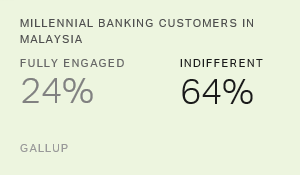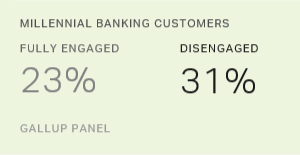Story Highlights
- The fintech revolution and economic changes are major threats
- Most Malaysian millennials are indifferent about their banks
- Banks need to discover how to enhance customer engagement
Banks in Malaysia face a series of challenges.
They're still on the mend following the 1997 economic crisis, and the "fintech" -- financial technology -- revolution, together with the growing digital banking trend, is rewriting how business gets done.
What's more, Malaysian banks are struggling to connect with an emerging millennial population. Millennials -- those born between 1980 and 1996 -- are becoming a dominant presence in the marketplace, and Malaysian banks are doomed to stagnant growth if they fail to appeal to these young consumers.
Unfortunately, ���۴�ýfinds that 60% of Malaysian banking customers overall and 64% of millennial banking customers are indifferent toward their primary banks. These customers are neutral -- they neither love nor hate the brand -- and they cost banks money: On average, indifferent banking customers in Malaysia have a net return rate of 0%.
On the other hand, fully engaged customers have strong positive feelings toward their primary banks. In addition to spending more and staying longer with their banks, they also rally their social circles on their banks' behalf. This unparalleled emotional loyalty translates to higher business performance and profitability -- from increased wallet share and number of products used to greater brand advocacy. In Malaysia, fully engaged banking customers provide banks an average net return rate of +23%.
However, garnering customers' loyalty and business amid economic and technological changes is easier said than done. First, banks need to understand what it takes to build and then objectively evaluate how well they're hitting that mark.
In its 2016 Malaysia banking industry study -- one of the largest of its kind to date -- ���۴�ýhas unearthed insights to help leaders enhance customers' emotional engagement and foster more loyal and lucrative customer relationships.
Four Key Findings That Banks Must Address
- A majority of Malaysian banking customers (60%) are indifferent toward their primary banks. Malaysian banking customers have not experienced enough differentiated service from their main banks to sway their preferences, loyalty or repurchase behaviors.
- When it comes to banking channels, customers care about quality more than quantity. Banks need to focus on consistently delivering solutions instead of simply completing transactions. Banking customers in Malaysia want more quality and consistency across physical and digital channels.
- Malaysian banking customers want more than products from their banks -- they want their banks to look out for their financial well-being and serve as . While Malaysian banking customers seem to be happy with the overall service their primary banks provide, their expectations for building a positive relationship with their banks are unmet. Malaysian banking customers want advice on how to fulfill their financial goals and demonstrate a commitment to their financial futures -- not just products.
- Disengaged millennials -- not other banking competitors -- pose the greatest threat to Malaysian banks today and in the near future. Nearly seven in 10 Malaysian millennials (64%) are indifferent toward their main banks, while a dismal 24% are fully engaged. On average, Malaysian millennials consistently use just two banking channels, giving banks only a small window of opportunity to and win more of their business.
���۴�ýhas also found that customer engagement matters more than satisfaction or advocacy in driving positive outcomes. Though satisfaction and advocacy show some links to improved customer behavior, only customer engagement is predictive of high performance across four critical measures for the majority of a bank's customer base. For example, 75% of fully engaged Malaysian banking customers feel strongly that their banks are the best banks for them, compared with just 40% of customers who are "extremely satisfied" or 43% of customers who are "promoters."
How Financial Leaders Can Enhance Customer Engagement
Urgently combat customer indifference. First and foremost, Malaysian banks need to focus on building customer engagement. Leaders should aim to differentiate their brand and leverage a variety of strategies for engaging customers, including emphasizing customers' financial health and focusing on building meaningful relationships with customers.
Evolve from an "omnichannel" (many channels) to an "optichannel" (customers' preferred channels) strategy. Customers expect perfect service in each interaction more than they desire the convenience of a variety of channel options. Banks should offer both omnichannel and optichannel experiences, providing customers with the convenience of multiple channels while ensuring that customers can use their preferred channels for streamlined, coordinated experiences.
Combine digitalization with human interactions as a way of attracting and engaging customers across a range of demographics. Banks need to provide five-star experiences across multiple channels as part of a seamless customer experience -- a strategy that engages all types of customers. Though digital interactions are increasing, branch experiences are still paramount, especially because younger customers tend to seek advice and support in person.
Reinvent sales and service processes in transforming branch and call center customer experiences. Many Malaysian banks have embarked on large-scale transformations that include radical changes to technology, processes and systems. However, to enhance engagement, banks should implement structured routines and processes -- such as ongoing coaching and short-cycle management systems -- across branches and call centers.
Place customer engagement -- and customer centricity -- at the heart of the bank's infrastructure and operating strategy. Any organization seeking to drive customer engagement needs to make its customer engagement initiative central to its strategy. Leaders should regularly remind employees of the bank's overarching goal -- a customer-centric culture -- and equip them to build and maintain a culture of engagement.
Bailey Nelson contributed to this article.



